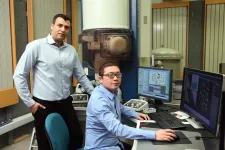(Press-News.org) ORLANDO, Jan. 11, 2021 - Data from Arecibo Observatory in Puerto Rico has been used to help detect the first possible hints of low-frequency disturbances in the curvature of space-time.
The results were presented today at the 237th meeting of the American Astronomical Society, which was held virtually, and are published in The Astrophysical Journal Letters. Arecibo Observatory is managed by the University of Central Florida for the National Science Foundation under a cooperative agreement.
The disturbances are known as gravitational waves, which ripple through space as a result of the movement of incredibly massive objects, such as black holes orbiting one another or the collision of neutron stars.
It's important to understand these waves as they provide insight into the history of the cosmos and expand researchers' knowledge of gravity past current limits of understanding.
Although the gravitational waves are stretching and squeezing the fabric of space-time, they don't impact humans and any changes in the relative distances between objects would change the height of a person by less than one one-hundredth the width of a human hair, says Joseph Simon, a postdoctoral associate in the Center for Astrophysics and Space Astronomy at the University of Colorado Boulder.
Simon presented the findings at the society today, is lead researcher of the paper, and is a member of the North American Nanohertz Observatory for Gravitational Waves, or NANOGrav, the team that performed the research.
NANOGrav is a group of more than 100 astronomers from across the U.S. and Canada whose common goal is to study the universe using low-frequency gravitational waves.
In 2015, NSF's Laser Interferometer Gravitational-Wave Observatory (LIGO) made the first direct observation of high frequency gravitational waves using interferometry, a measurement method that uses the interference of electromagnetic waves.
The new findings made by NANOGrav researchers are unique because the astronomers found possible hints of low-frequency gravitational waves by using radio telescopes, since they cannot be detected by LIGO. Both frequencies are important for understanding the universe.
Key to the research were two NSF-funded instruments - Green Bank Telescope in West Virginia and Arecibo Observatory in Puerto Rico.
Arecibo Observatory, with its 1,000-foot diameter dish provided very precise data, while the Green Bank Telescope, which has much larger sky coverage, sampled a wider range of information needed to discriminate gravitational wave perturbations from other effects, Simon says.
"We time roughly half the pulsars with each telescope," he says. "Each telescope provides about half of our total sensitivity in a complementary way."
Although the researchers used Arecibo data for the study, they are no longer able to make observations with it since the observatory collapsed in December following broken cables in August and November.
"It was a truly horrible day when the telescope collapsed," Simon says. "It feels like the loss of a good friend, and we are so saddened for our friends and colleagues in Puerto Rico. Going forward, we hope to increase the amount of time we use on the Green Bank Telescope to at least partially compensate for Arecibo's loss. Another large collecting area radio telescope must be built in the U.S. soon if we want this research area to flourish."
The researchers were able to detect possible hints of low-frequency gravitational waves by using the telescopes to study signals from pulsars, which are small, dense, rotating stars that send out pulses of radio waves at precise intervals toward Earth.
This regularity make them useful in astronomical study, and they are often referred to as the universe's timekeepers.
Gravitational waves can interrupt their regularity, causing deviations in pulsar signals arriving on Earth, thus indicating the position of the Earth has shifted slightly.
By studying the timing of the regular signals from many pulsars scattered over the sky at the same time, known as a "pulsar timing array," NANOGrav was able to detect minute changes in the Earth's position possibly due to gravitational waves stretching and shrinking space-time.
NANOGrav was able to rule out some effects other than gravitational waves, such as interference from the matter in the solar system or certain errors in the data collection.
To confirm direct detection of a signature from low-frequency gravitational waves, NANOGrav researchers will have to find a distinctive pattern in the signals between individual pulsars. At this point, the signal is too weak for such a pattern to be distinguishable, according to the researchers.
Boosting the signal requires NANOGrav to expand its dataset to include more pulsars studied for even longer lengths of time, which will increase the array's sensitivity. In addition, pooling NANOGrav's data together with those from other pulsar timing array experiments, a joint effort by the International Pulsar Timing Array, may reveal such a pattern. The International Pulsar Timing Array is a collaboration of researchers using the world's largest radio telescopes.
At the same time, NANOGrav is developing techniques to ensure the detected signal could not be from another source. They are producing computer simulations that help test whether the detected noise could be caused by effects other than gravitational waves, in order to avoid a false detection.
"It is incredibly exciting to see such a strong signal emerge from the data," Simon says. "However, because the gravitational-wave signal we are searching for spans the entire duration of our observations, we need to carefully understand our noise. This leaves us in a very interesting place, where we can strongly rule out some known noise sources, but we cannot yet say whether the signal is indeed from gravitational waves. For that, we will need more data."
Benetge Perera, a scientist at Arecibo Observatory who is a specialist in using observations of pulsars for the detection of gravitational waves, says the research aims to open a new window in the spectrum of gravitational wave frequencies.
"A low-frequency gravitational wave detection would enhance our understanding of supermassive black hole binaries, galaxy evolution, and the universe," says Perera, who is also a member of NANOGrav.
He says that despite the collapse of Arecibo Observatory, there are still much archived data to pore through to continue to learn about gravitational waves.
"Arecibo was very important as its timing data provided about 50 percent of NANOGrav's sensitivity to gravitational waves," he says. "I want to ensure that the sensitive data we collected before Arecibo's collapse has the highest possible scientific impact."
INFORMATION:
CONTACT: Robert H. Wells, Office of Research, robert.wells@ucf.edu
CAMBRIDGE, MA -- When we experience a new event, our brain records a memory of not only what happened, but also the context, including the time and location of the event. A new study from MIT neuroscientists sheds light on how the timing of a memory is encoded in the hippocampus, and suggests that time and space are encoded separately.
In a study of mice, the researchers identified a hippocampal circuit that the animals used to store information about the timing of when they should turn left or right in a maze. When this circuit was blocked, the mice were unable to remember which way they were supposed to turn next. However, disrupting the circuit ...
North Carolina State University-led researchers have developed an analytical measurement "framework" which could allow organic solar cell researchers and manufacturers to determine which materials will produce the most stable solar cells prior to manufacture.
Organic solar cells have increased in efficiency over the past decades, but researchers and manufacturers still struggle with determining which material combinations work best and why, as well as with achieving stable morphology and operation.
"There is still a lot of 'trial and error' guesswork involved in identifying promising materials for these solar cells," says Harald Ade, Goodnight Innovation Distinguished Professor of Physics at NC State and co-corresponding author of the research. ...
Two studies in today's Nature Neuroscience, led by researchers at Boston Children's Hospital, Brigham and Women's Hospital (BWH), and Harvard Medical School (HMS), implicate mosaic mutations arising during embryonic development as a cause of autism spectrum disorder (ASD). The findings open new areas for exploring the genetics of ASD and could eventually inform diagnostic testing.
Mosaic mutations affect only a portion of a person's cells. Rather than being inherited, they arise as a "mistake" introduced when a stem cell divides. A mutation in a stem cell will only be passed to the cells that descend from it, producing the mosaic pattern. ...
Reza Shahbazian-Yassar, professor of mechanical and industrial engineering at the University of Illinois Chicago.
Shahbazian-Yassar and colleagues facilitated the development of a cutting edge "Swiss Army knife" catalyst made up of 10 different elements - each of which on its own has the ability to reduce the combustion temperature of methane - plus oxygen. This unique catalyst can bring the combustion temperature of methane down by about half - from above 1400 degrees Kelvin down to 600 to 700 degrees Kelvin.
Their findings are reported in the journal Nature Catalysis.
In previously-published research, ...
Tales of post-apocalyptic landscapes in which few survivors emerge into a new and much different world have long been popular tales woven by screenwriters and authors. While many enjoy these stories, thinking of them as nothing but a guilty pleasure, they may not realize that immersing themselves in fiction has prepared them for the reality of 2020, according to a team of researchers.
John Johnson, professor emeritus of psychology at Penn State, recently conducted research with several colleagues revealing that an individual's enjoyment of horror films could have better prepared them for the COVID-19 pandemic as opposed to others who do not enjoy frightening entertainment. Their findings are documented in Personality and Individual Differences.
"My latest ...
The first-ever study of the levels of the stress hormone cortisol in the saliva of newborn white-tailed deer fawns yielded thought-provoking results that have Penn State researchers suggesting predation is not the only thing in the wild killing fawns.
"We think the hormone offers a way to evaluate factors in the environment that affect fawns, such as disease, but are difficult to evaluate when just looking at a carcass that has been picked over by predators," said researcher Duane Diefenbach, adjunct professor of wildlife ecology. "By then, it's impossible to be certain what ...
University of Wyoming researchers headed a study that shows nonnative birds in Oahu, Hawaii, have taken over the role of seed dispersal networks on the island, with most of the seeds coming from nonnative plants.
"Hawaii is one of the most altered ecosystems in the world, and we are lucky enough to examine how these nonnative-dominated communities alter important processes, such as seed dispersal," says Corey Tarwater, an assistant professor in the UW Department of Zoology and Physiology. "What we have found is that not only do nonnative species dominate species ...
Boston, Mass. - As the number of COVID-19 infections continues to rise nationwide, more than 360,000 Americans have already died from the potentially deadly viral infection. But recent reports describe an increase in mortality during the pandemic that cannot be explained by COVID-19 deaths alone.
In a new study from the Richard A. and Susan F. Smith Center for Outcomes Research in Cardiology at Beth Israel Deaconess Medical Center (BIDMC), researchers analyzed data from the National Center for Health Statistics to compare the rate of cardiovascular-related deaths before and after the onset of the pandemic in ...
Mindfulness courses can reduce anxiety, depression and stress and increase mental wellbeing within most but not all non-clinical settings, say a team of researchers at the University of Cambridge. They also found that mindfulness may be no better than other practices aimed at improving mental health and wellbeing.
Mindfulness is typically defined as 'the awareness that emerges through paying attention on purpose, in the present moment, and nonjudgmentally to the unfolding of experience moment by moment'. It has become increasingly popular in recent years as a way of increasing wellbeing and ...
Deaths from ischemic heart disease and hypertensive diseases in the United States increased during the COVID-19 pandemic over the prior year, while globally, COVID-19 was associated with significant disruptions in cardiovascular disease testing. These findings are from two papers publishing in the Journal of the American College of Cardiology that examined the indirect effects of the pandemic on cardiovascular disease patients and their care.
The impact of the COVID-19 pandemic has been substantial, but there are concerns about the indirect impact of the pandemic as well, particularly for heart disease patients. Many reports have suggested that large mortality increases during the pandemic cannot be explained by COVID-19 alone. During the height of stay-at-home orders in the U.S., hospitals ...



